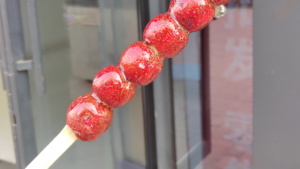I moved to Xi’an in 2014 and instantly fell in love with its food scene. Among all the dishes I tried, one stood out: Biang Biang noodles.
These noodles aren’t just delicious—their name alone is enough to spark curiosity. As I learned more about them, I uncovered quirky stories and fascinating history behind this humble yet iconic dish, which costs just a few yuan.
How to Write “Biang”? – The Most Complex Chinese Character
Biang Biang noodles are one of Shaanxi’s “eight culinary wonders.” The “Biang” is famous for being the most complex Chinese character, with 58 strokes!

Here’s the kicker: “Biang” isn’t even an official Chinese character. If you type “Biang Biang mian” on a Chinese keyboard, you won’t find the character. The ones you see on shop signs are unofficial creations.
Despite this, the intricate “Biang” character has brought fame to the noodles—even most Chinese people can’t write it!
So, Where Did “Biang” Come From?
First, the Sound
The word “Biang” is an onomatopoeia, inspired by the sound of noodles being made.
If you are curious about the the pronunciation of “Biang”, click to play.
Legend has it that during the Qin Dynasty, soldiers loved noodles but didn’t have rolling pins or chopping boards. A cook found a quick fix: he pulled dough into long, thick strips that made a “Biang, Biang” noise as they hit a board. These belt-like noodles became popular, and the name stuck.
Then, the Character
One story says a hungry scholar from Shaanxi visited a noodle shop but couldn’t pay for his meal. He asked the owner if writing the word “Biang” would cover the cost. Thinking no one could write it, the owner agreed. But to his surprise, the scholar created the now-famous complicated “Biang” character in just one try!
If you want to know how to write “Biang”, you can refer to the gif below:

What Does Biang Biang Noodles Look Like?
Biang Biang noodles‘s bold flavors and appetizing look also make them a must-try. A bowl of Biang Biang noodles usually comes dry, with no soup. The noodles are wide, long, and chewy—you’ll often get just 3 to 5 noodles in a bowl because they’re so big. I wasn’t a big noodle person myself, but one bowl of authentic Biang Biang noodles in Xi’an completely changed my mind. Even after back to Shenzhen, I searched everywhere for a good Shaanxi noodle shop. If you love spicy food, this dish is irresistible.

This is a bowl of beef Biang Biang noodles I recently ordered from a noodle shop in a busy residential area in Xi’an. It is very authentic.
How Are Biang Biang Noodles Served?
Traditionally, these noodles come in a large bowl with toppings like chilli oil, garlic, and soy sauce. The toppings vary by shop, but here are some common options:
- Classic (招牌)
- Tomato and egg
- Beef
- Vegetables
- 3-in-1
- 4-in-1
The number before “1” represents the number of toppings. For example, “4-in-1” has four types. For example, my 4-in-1 bowl included braised beef cubes, potatoes, tomatoes, and eggs. Of course, the combinations depend on the noodle shop, so there’s always something new to try.
To eat, stir everything together to coat the noodles in sauce. Each bite is hot, tangy, and bursting with flavor. The chewy noodles, rich wheat aroma, and spicy toppings create a delicious and addictive combination.
Eat It Like a Local – With Garlic!
In Xi’an, eating Biang Biang noodles with garlic is a tradition. Most noodle shops have plates of garlic on every table.

Here’s how locals eat it:
- Mix the noodles with the sauce.
- Peel a clove of garlic.
- Take a bite of garlic and follow it with a bite of noodles.
Garlic adds a spicy kick and balances the flavors. It’s also said to help with digestion and is a good match for Xi’an’s dry climate.
Pro tip: If you’re not a fan of garlic breath, keep gum or mints handy!
Where to Find the Best Biang Biang Noodles in Xi’an
While Xi’an is famous for its food, the noodles near tourist spots are often overpriced and average in taste. For the best experience, check out these highly rated local noodle shops:
Near the Museum of Qin Terracotta Warriors and Horses
- 清真.老杨家biangbiang面.烤肉(秦始皇大剧院店)
- 清真.回坊大牌档.陕菜
- 子午路张记肉夹馍(兵马俑店)
- 秦膳坊
Near Giant Wild Goose Pagoda in Xi’an or the Shaanxi History Museum
- 大嘻咹biangbiang面
- 永丰岐山面(雁塔北路店)
- 焦记biangbiang面(翠华路店)
- 金盆油泼面(大雁塔店)
- 长安情biangbiang面(翠华路店)
Around the Xi’an Muslim Quarter
- 子午路张记肉夹馍(五味什字店)
- 陕小面.李家biangbiang面(钟楼店)
- 醉长安(钟楼旗舰店)
If you want more recommendations for noodle restaurants near Xi’an’s tourist attractions, please leave me a message!
Final Thoughts
Shaanxi is a noodle lover’s paradise, and Biang Biang noodles are the star of the show. Their bold, spicy flavors and fascinating backstory make them a unique culinary experience.
If you visit Xi’an, you absolutely have to try them—it’s a taste you’ll never forget.



